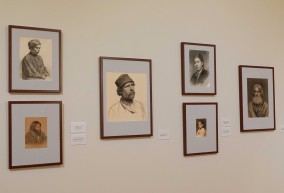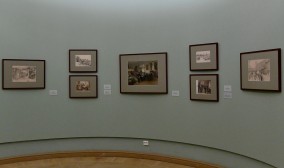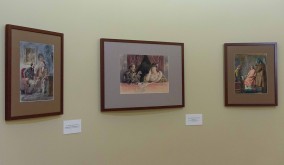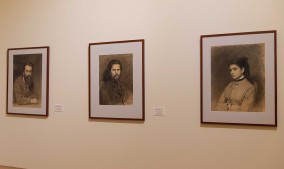Exhibition «Drawings and Watercolours by the Wanderers»
The Drawings and Watercolours by the Wanderers exhibition acquaints viewers with graphic works created by the founders of the Society of Travelling Art Exhibitions (1870–1923), as well as by artists of the younger generation.
The Society of Travelling Art Exhibitions brought together artists who believed that art could influence people’s spiritual world. Exhibitions held in many cities made it possible to introduce art to the wider public. This period is marked by an extraordinary spiritual upsurge giving rise to Leo Tolstoy, Fyodor Dostoevsky, Nikolai Leskov, Ivan Goncharov, Alexander Ostrovsky, Mikhail Saltykov-Shchedrin and Nikolai Nekrasov in literature; Pyotr Tchaikovsky and Modest Mussorgsky in music; Ilya Repin, Vasily Surikov, Ivan Kramskoi and Vladimir Makovsky in fine arts. These artists formed the core of the Russian realist school of painting of the second half of the 19th century.
Portrait drawings from the 1870s, mainly done in graphite pencil and sauce, depict the features of peasants and intelligentsia representatives of different social classes. Their images are characterized by deep psychologism and striving for revealing general and peculiar features typical of their generation. Such works as Ilya Repin’s Intellectual (Portrait of Chagin from Chuguev), Nikolai Yaroshenko’s Portrait of a Young Woman and Ivan Kramskoi’s Peasant Ignaty Pirogov are particularly significant. Portraits of the 1880s, retaining psychologism and typification, distinctly emphasize the portrayal itself in order to express more clearly an artist’s attitude to a model. In Ilya Repin’s graphic work Artist Nikolai Dubovskoi the sitter seems to have been taken out of time.
The genre of landscape in graphic works by the Wanderers developed considerably, but one thing remained unchanged: the motifs of native nature replaced the interest in the beauty of Italy, which had so attracted the artists of the first half of the 19th century. The 1870s landscapes by Karl Huhn and Vasily Maximov reveal the artists’ sincere enthusiasm for simple motifs and amaze viewers with the mastery of their execution. Ivan Shishkin’s virtuoso landscape drawings are just as important as his paintings. In the 1880s, the depiction of nature acquired new characteristics.The descriptive manner gave way to a more general interpretation. The landscape, retaining its realistic features, started to express an artist’s feelings full of lyricism and poetry. This is even more true of Isaac Levitan’s watercolours.
In the Wanderers graphic art a large place was occupied by genre painting. Vladimir Makovsky’s colourful watercolours of the 1870s convey subtle observations on human characters appearing in the scenes with a detailed plot and filled with humour. The 1880s were the heyday of genre painting. Vasily Maximov and Nikolai Zagorsky, as well as Ilya Repin with his famous series of drawings dedicated to St Petersburg, paid tribute to the genre.
In the 1890s, paintings and graphic works by the Wanderers more and more clearly reflected a new trend: the generalization and sketching in interpreting works prevailed over their narration and completeness. The Society of Travelling Art Exhibitions granted membership to only a few young artists who followed this new trend. Many artists participated in the society’s exhibitions as contributors, including Elena Polenova and Nikolai Gritsenko. Their watercolours contrast with the landscape drawings and watercolours of the 1890s by Alexei Savrasov, Grigory Myasoyedov and Alexei Bogolyubov and mark the final stage in the history of travelling art.
Graphic works by the Wanderers supplement the idea of the work of artists whose paintings became significant events in social life.
Age restriction: 0+
The exhibition is supported by Severstal, Dobrotasevera, Power Machines, Lenta, Nordgold, Sveza, Fun&Sun company, Scandinavia.
The exhibition is held in the St Michael’s Castle until July 08, 2024.
tags cloud
- #opening_of_a_branch
- #lecture
- #exhibition
- #virtual_exhibition
- #virtual_tour
- #online_exhibition
- #мультимедийная_выставка
- #poster_exhibition
- #online_event
- #masterclass
- #contest
- #занятие
- #festival
- #video_conference
- #round_table
- #conference
- #seminar
- #дошкольники
- #школьники
- #студенты
- #семья
- #серебряный_возраст
- #инклюзия
- #multimedia
- #Business_meeting_of_virtual_brances
- #The_Multimedia_Centre
- #Drammatika
- #деньмузеевВФРМ
- #ночьмузеевВФРМ
- #RussianMuseum130
- #RussianMuseum125
- #RussianMuseum120
- #RMcatalogues
- #Библионочь
- #книгиГРМ2019
- #игрыРМ
- #фильмыРМ
- #ночьискусствВФРМ
- #Artefact
- #100years_restorationRM
- #Peter_I_350
- #Antarctica200
- #folk_art
- #profession_restorer
- #RM_anniversary
- #SPb_anniversary
- #80летПобеды



